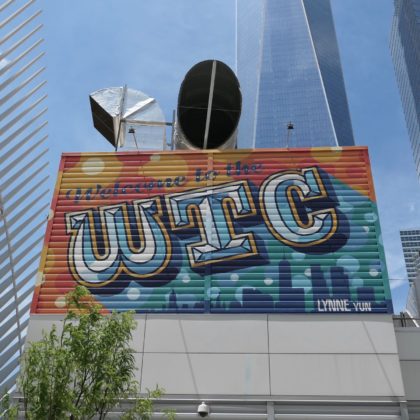In the News: Residents Argue Against the Jail Plan
••• “Residents living near the site of a proposed new jail at 80 Centre St. slammed the plan at the first public meeting on the project, held last Thursday with city officials.” —Tribeca Trib
••• “At the September 5 meeting of the Battery Park City Committee of Community Board 1, engineer Matt Krenek announced that the long-awaited West Thames pedestrian bridge will not open until the second half of 2019.” —Broadsheet
••• “David Rockwell designed the new middle-school campus for the Blue School, founded by members of the alternative-theater Blue Man Group.” —New York Times
••• I was hoping that Curbed‘s annual “Status of the World Trade Center Complex” would include info on when the Church Street side of 3 World Trade Center and the Cortlandt Way pedestrian walkway between 3 and 4 World Trade Center will be done, but no. There’s also no estimate as to when the performing arts center will be done. UPDATE: I spoke to soon, in part. “The remainder of Cortlandt Way between 3 and 4 WTC opened this morning,” reports Anthony.



















For those who missed the jail meeting, I would urge attendance at the next one, this Wednesday. Come with your questions and concerns.
“The next meeting, a town hall sponsored by Councilwoman Margaret Chin and Manhattan Borough President Gale Brewer, takes place Wednesday, Sept. 12, from 6 to 8 p.m at PS 124, 40 Division St.”
The remainder of Cortlandt Way between 3 and 4 WTC opened this morning.
In living memory, has any neighborhood anywhere in the City welcomed a facility for the poor or for those with social stigmas (alcohol, drugs, crime)? Aside from dumping them
all in remote places (Jury Duty on Rikers Island? Cool!), how does anyone propose solving the problem?
With decriminialization of marajuana and the end of stop and frisk, will the Rikers population decrease further? Will bail reform initiatives have an impact? The size of the population at Rikers is the result of public policy as much as it is by the crime rate.
I wonder if “community use” spaces will exist in perpetuity. I’m thinking of promises made by developers for public spaces and the g radial takeover of “community” spaces in some public housing projects.
Thoughtful –
Good questions, but a few thoughts in partial response:
– The neighborhood already has a huge complex for such purpose (The so-called “Tombs”, or Manhattan Detention); the resistance is to putting in a much larger such facility with much larger population, and the concern is over the effects over this massive local expansion to the neighborhood: safety, congestion, etc.
– The closure of Rikers and move to such local facilities is insanely expensive, and sure to grow and grow in price
– Arguments have been made that this entire project will not resolve the problems (such as violence) of Rikers, but only move
– We need a more convincing argument why reform cannot be done at Rikers, or some other location away from populated centers
– Decrease of the prison population can happen just as well at Rikers as anywhere else, so that’s actually a separate issue altogether and not a good argument for the moves. So one can consistently be in favor of reducing the prison population and against the closure of Rikers and move to these local facilities
The further a facility is from populated areas, the worse it is for the inmates, because it makes it much harder for their families to reach them. Maintaining family and community ties during incarceration is critical to inmates futures.
Most important would be reforming the cash-bail system and ensuring adequate mental health treatment outside jail complexes like Rikers, which are ill-equipped to deal with such problems and serve mostly to incubate and exacerbate them. That being said, once dysfunction, neglect and violence becomes entrenched in any institution, closing it and starting over with different programs, etc. might be the only option. Whether it would work is unknown – but something has to change.
The Tombs house’s only male inmates awaiting trial. Rikers Houses males and females. It consists of ten jails, holds local offenders who are awaiting trial and cannot afford, obtain, or are not given bail from a judge; those serving sentences of one year or less; and those temporarily placed there pending transfer to another facility.
The neighborhood has a well established aversion to anyone with even the slightest involvement with the criminal justice system, as seen in the Summons Court hysteria a few years ago. Given the percentage of people of color who have criminal justice involvement, one could argue that poor people of color are just seen as a threat.
“Given the percentage of people of color who have criminal justice involvement, one could argue that poor people of color are just seen as a threat.”
That’s an unsupported argument.
One could argue that massively expanding a facility housing criminals regardless of background is seen as undesirable in a residential neighborhood. The tightly drawn area for the analysis of the environmental impact of the jail is a joke designed to sidestep this fact.
Your concern is more about the inmates and their “futures” than the neighborhood and its residents.
“The further a facility is from populated areas, the worse it is for the inmates, because it makes it much harder for their families to reach them. Maintaining family and community ties during incarceration is critical to inmates futures.”
– If true, this argument has to be weighed against the concerns and effects on the surrounding community “gaining” such a facility.
– Communication with family et al does not always require in-person visits; as with so many business, legal, and personal relationships and communications, telephone and video chat/conference can work very well.
– If the insistence is still on easy in-person access to “family and community”, then the facility should be placed in the neighborhood of origin for most of its inmates. Is Chinatown/TriBeCa that neighborhood?
“That being said, once dysfunction, neglect and violence becomes entrenched in any institution, closing it and starting over with different programs, etc. might be the only option.”
What is the evidence that this is the only option? Why not restructure the existing facility instead?
“Whether it would work is unknown – but something has to change.”
It’s troublesome and potentially disastrous policy to just change “something” without compelling evidence that the “something” will actually improve matters, rather than just maintain the status quo, or actually make matters worse. That’s a very expensive experiment, and there are arguments that it will not work:
“Investigation chief: Moving Rikers inmates won’t stop jail violence”
https://nypost.com/2018/03/26/investigation-chief-moving-rikers-inmates-wont-stop-jail-violence/
“The neighborhood has a well established aversion to anyone with even the slightest involvement with the criminal justice system…”
As you said in your first comment, isn’t this true of any neighborhood? And isn’t it quite a reasonable concern?
Furthermore, this neighborhood already has a huge facility for the “criminal justice system”. The argument is that this neighborhood has already taken on more than enough of this civic responsibility to host “criminal justice” infrastructure.
“Given the percentage of people of color who have criminal justice involvement, one could argue that poor people of color are just seen as a threat.”
That’s pure speculation and would require evidence. One might just as well speculate on a potentially racist motive involved in putting this facility in an Asian community. Either claim would require evidence. Let’s not carelessly fan the fires of racial tensions.
Historically the area around the Courts and Manhattan Detention Center (via 5 Points) was not an Asian neighborhood. The expansion of Chinatown is relatively new in the area’s long and diverse history.